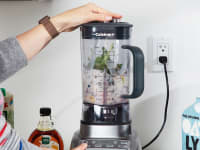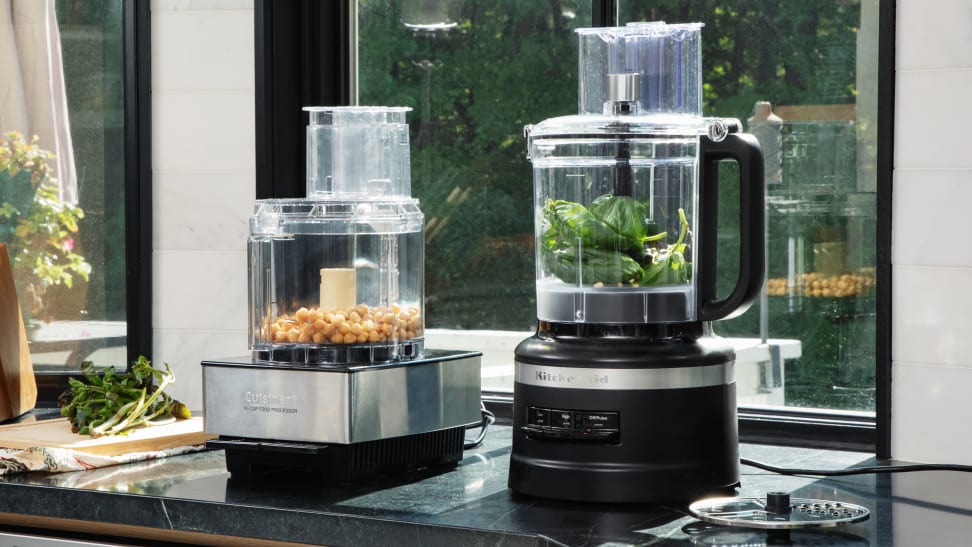 Credit:
Reviewed / Timothy Renzi
Credit:
Reviewed / Timothy Renzi
Products are chosen independently by our editors. Purchases made through our links may earn us a commission.
The food processor is among the most versatile countertop appliances in the kitchen when it comes to food prep. If you don't own one, you're missing out, and even if you do own one, it's probably not getting the love it deserves. Whether you're making pesto, breading, sauce, muffins, or pastries, there’s likely a way you can use your food processor to prep.
It may take up a fair bit of counter or cabinet space, but a food processor can perform such a wide variety of tasks that it can replace several smaller kitchen tools. (We're looking at you, cheese grater!) Additionally, the best food processors come with attachments that enable you to do even more prep than what's listed above. Let’s dive into full culinary geek mode on food processors.
What is a food processor?
A food processor is a motorized kitchen appliance with a blade and other accessories that can chop, mix, puree, emulsify, grate, and shred.
Types of food processors
- Full-sized processors (For the dedicated home chef): With a capacity between 12 cups and 14 cups, a full-sized food processor can tackle anything from a batch of hummus to a double-batch of pizza dough. Our favorite is the KitchenAid KFP1318 13-cup food processor, for its easy-to-use design and smooth operation.


Our pick for the best full-sized food processor for your kitchen.
Read Our Review- Compact processors (For smaller kitchens and quick tasks): For quick kitchen tasks like a small batch of salsa, chopping an onion, or pureeing baby food, you can use a mini food processor with a 3- to 7-cup capacity. If you hate chopping garlic but love making meatballs, a mini food processor is the answer.

A powerful yet compact food processor for a variety of prep tasks.
- Specialty or pro-style food processors (For extra help in the kitchen): If you want even more powerful prep help in the kitchen, some food processors come with multiple types of blades, slicing disks, a mini-bowl that fits inside the main bowl, and a storage case. The Breville Sous Chef 16-Cup Food Processor is one such option with a 16-cup capacity and accessories galore.

Our pick for the best full-sized food processor for your kitchen.
How do you use a food processor?
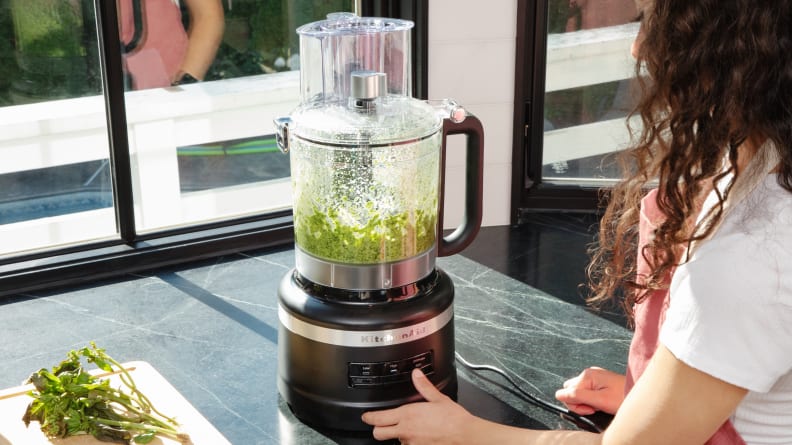
The settings are simple but there are so many ways to use your food processor!
Two main features define this appliance—its settings and its blade(s).
Settings: Speed, pulse, and more
Most food processors come with simple settings like On and Pulse, or Low and High. Many require you to hold the button down to run the machine.
Pulsing allows you to chop ingredients in short bursts. Whether you accomplish this with short pushes of the On button or use a Pulse button, the action is the same. This function is best used when adding large chunks of food to the processor, as it allows you to chop them down to a manageable size. Even if you're going to eventually blend or puree the ingredients, it’s a good idea to pulse the big pieces first so they don’t get stuck in the blade.
When you puree in your food processor, the blade blends ingredients continuously. This is the perfect setting for making pesto, hummus, and tomato sauce. Most processors allow you to control the blade speed, typically with high and low settings. A high speed will emulsify your ingredients more, while a low speed will leave you with chunkier bits.
High-end models may also come with more advanced chopping options, but for the most part, these standard settings work perfectly. It's more important to have a powerful model, which is one of the key aspects we tested to find the best food processors.
Note that you won’t get quite as smooth results from a food processor as you can with a blender because the blender blades are designed differently, and food processors don’t make the same vortex that draws ingredients down to the blender blades.
Attachments: Blades, discs, and more

Most food processors come with a blade as well as disks for slicing and grating.
Food processors have a removable blade, which not only makes cleaning much easier but also allows you to change out for a variety of specific attachments. You’ll want to use your standard blade for pulsing and pureeing, but there are a few common attachments that are helpful for other food prep.
Grating Disc: A grating attachment works well for items like carrots, potatoes, and cheese. To use it, remove the standard blade and place the grating disc on the stem in your processor. Reattach the lid, then remove the pusher from the feed tube—that's the little "chimney" that allows you to drop ingredients into the processor. Hold the On or Pulse button and add your ingredient through the tube. You should use the pusher to press your ingredient further into the processor. Do not use your fingers!
Slicing Disc: To slice an ingredient, follow the same steps as grating, but use the attachment that has a thin slicing line across it. You can use this attachment to thinly slice cucumbers, shave Brussels sprouts, make potato gratin, or slice up other produce.
Dough Blade: Some food processors come with a plastic dough blade, which can be used to knead bread and pastry dough, although America’s Test Kitchen suggests that the regular blade is better for this task, so you many not find many uses for the dough blade.
Do you need to prep food before using?
A food processor will surely make kitchen prep work easier and faster, but there are still a few things you need to do first to get the most out of using your food processor.
Pre-cut or whole? Preparing your food for the processor
Even if you’re using the food processor to save time prepping veggies, grating cheese, or making salsa, it’s best to break down whole produce into chunks before processing. You’ll get more even results, and the processor will perform better.
You’ll also need to cut ingredients like potatoes and cheese into narrower pieces to fit them into the feed tube for grating or slicing. Don’t forget to wash and dry produce before processing so you don’t introduce excess water into your mixture.
Uses and techniques
Your food processor can do everything short of actually cooking your food. Here are some quick tips on how to use it to its fullest potential.
Chopping, slicing, grating
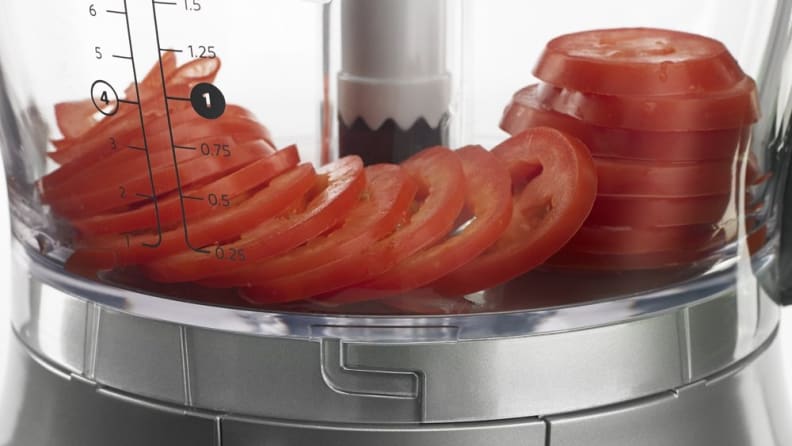
The slicing disc will create uniform slices of veggies or cheese.
Chop dry ingredients: Use the pulse feature to chop larger foods into small pieces. Press and release the button until you've reached the desired size. This can be done to anything from onions and carrots to nuts and seeds.
Puree wet ingredients: Use the puree setting to combine wet and dry ingredients and create an emulsified consistency. Hummus, for example, is easy to make in your processor.
Mix and blend ingredients: Remember when we were talking about pastries? Your processor isn’t limited to savory dishes—you can make cookie or pastry dough in your processor, as the blades can chop and blend cold butter into dry ingredients.
Slice and grate ingredients: Use the disk attachments to finely slice anything you might otherwise use a mandoline or grater to prep.
Emulsifying dips, spreads, sauces
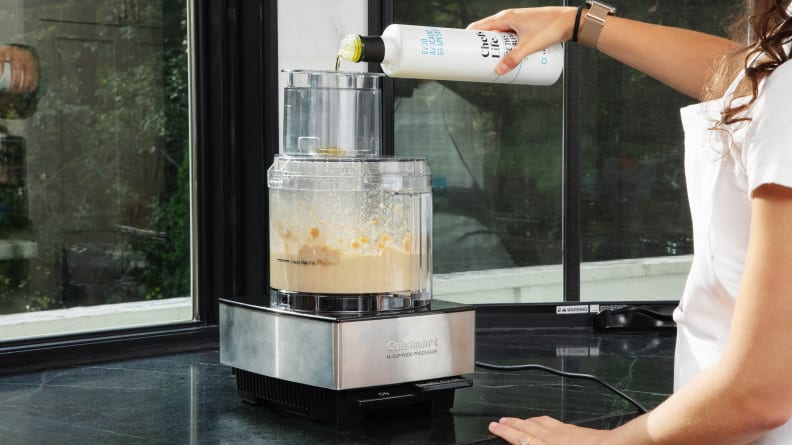
The feed tube is perfect for drizzling in olive oil or other liquids while making sauces, hummus, and more.
The feed tube in the lid of a food processor isn’t just for feeding ingredients into the disk blades. It’s also perfect for drizzling in olive oil, hot water, or other liquid ingredients while the processor is running. Adding liquids slowly while the machine is running will help to emulsify dips, sauces, and dressings. You can even make your own mayonnaise or aioli using this technique.
Cleaning, maintenance, and storage
The good news is that most food processor parts can go in the dishwasher, so cleaning isn’t as difficult or dangerous as it may seem. It’s important to separate all the parts to ensure every nook and cranny gets cleaned.
Pay close attention to the manufacturer’s instructions for cleaning because some parts may only be top-rack dishwasher safe.
Be particularly careful about storing the blades and disks. It’s best to store the blade inside the bowl of the processor, and if your food processor comes with a storage case for accessories, always store them in their intended spot. This will keep them sharp and prevent accidental injury.
When not to use a food processor
Soups
Food processors aren’t the ideal appliance for blending soups. They won’t puree as smoothly as a standard or immersion blender, and they can’t handle the capacity, especially with hot liquids that expand when processed.
If you’re making a small batch of soup that’s intended to be chunky, or you’re blending a chilled gazpacho, a food processor is useful. Otherwise, reach for a blender or immersion blender.
Mashed potatoes
Please don’t mash potatoes in your food processor. Chop, shred or grate raw spuds, but don’t use the appliance on cooked potatoes. When you use a sharp blade to mash potatoes, it breaks down the enzymes in the cooked vegetable and makes them unstable. This leads to gluey potatoes and a disappointing holiday side dish.
Our Experts
Danielle DeSiato managed kitchen coverage at Reviewed and has overseen testing of almost every type of countertop appliance, including food processors and blenders. From evaluating the vortex of a blender to create the smoothest smoothies, to determining if a food processor can effectively slice potatoes for gratin, she has spent countless hours assessing all the attributes that determine which appliances make the cut and which get cut from contention.
Kate Tully Ellsworth was the Executive Editor of Lifestyle & Commerce at Reviewed, overseeing editorial partner content and evaluating products with a keen eye for what works in real life.



